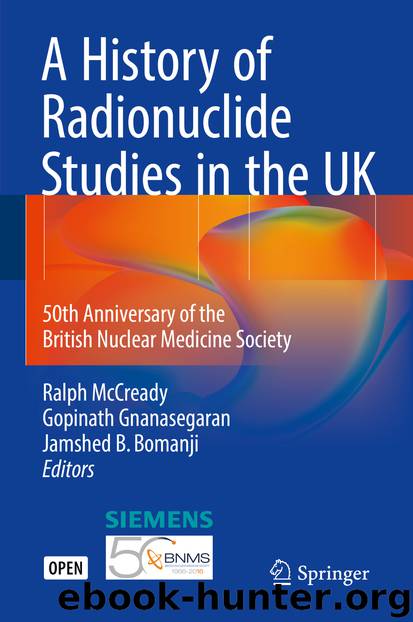A History of Radionuclide Studies in the UK by Ralph McCready Gopinath Gnanasegaran & Jamshed B. Bomanji

Author:Ralph McCready, Gopinath Gnanasegaran & Jamshed B. Bomanji
Language: eng
Format: epub
Publisher: Springer International Publishing, Cham
10.7 Frusemide Response
There are a number of ways of evaluating the response to Frusemide. Visually one may compare the rising second phase with the falling third phase of the activity time curve. If the rate of fall of the third phase before or after Frusemide is appropriate to the rate of rise of the second phase, then no Obstructive Nephopathy is likely. However using a T1/2 or other measure of the rate of fall of the third phase will be normal if renal function is good and abnormal if renal function is poor. It is not to be relied upon. Our usual protocol is to inject Frusemide at 16 min (F + 16) so that one can see the visual effect of Frusemide on any pelvic retention of tracer and its effect on the third phase of the activity time curve. When Frusemide is given 15 min before the start of the renal activity time curve, (F-15), which was previously used when the renogram was equivocal, the response to Frusemide cannot be assessed, except by comparison with a previous study without F-15. F-15 often causes the patient urinary urgency and may cause early termination of the study.
The numerical indices Outflow efficiency [15] and Parenchymal transit time index [16] avoid the need for F-15 in equivocal studies.
Whereas MAG3 is anionically bound, Cyclosporine is cationically bound in the kidney, hence the lack of reliability of Tc-99mMAG3 in this context of renal transplantation. Ajit Padhy and Kishor Solanki developed a new cationic binding agent Tc-99m DACH intended for the evaluation of cyclosporine toxicity [17]. Jamshed Bomanji among many other contributions showed the early beneficial effects of Lithotripsy on the outcome of the treatment of renal calculi [18]. We developed a ‘bootstrap’ model of the ‘Counter Current’ mechanism of urinary concentration with our systems analysis colleagues from City University [19]. In conclusion we emphasised that Nuclear Medicine allowed the appreciation and measurement of renal physiology and patho-physiological processes in man.
Since this section was to be related mainly to the work at St Bartholomew’s Hospital, I apologize for being unable to mention the works of many others in renal function measurements, renal transplants, renal tumours and Paediatrics. With their help, Renal Radionuclide studies have an established place in Nephrology and Urology.
Download
This site does not store any files on its server. We only index and link to content provided by other sites. Please contact the content providers to delete copyright contents if any and email us, we'll remove relevant links or contents immediately.
| Automotive | Engineering |
| Transportation |
Whiskies Galore by Ian Buxton(41879)
Introduction to Aircraft Design (Cambridge Aerospace Series) by John P. Fielding(33064)
Small Unmanned Fixed-wing Aircraft Design by Andrew J. Keane Andras Sobester James P. Scanlan & András Sóbester & James P. Scanlan(32743)
Craft Beer for the Homebrewer by Michael Agnew(18140)
Turbulence by E. J. Noyes(7935)
The Complete Stick Figure Physics Tutorials by Allen Sarah(7307)
Kaplan MCAT General Chemistry Review by Kaplan(6866)
The Thirst by Nesbo Jo(6826)
Bad Blood by John Carreyrou(6552)
Modelling of Convective Heat and Mass Transfer in Rotating Flows by Igor V. Shevchuk(6391)
Learning SQL by Alan Beaulieu(6209)
Weapons of Math Destruction by Cathy O'Neil(6142)
Man-made Catastrophes and Risk Information Concealment by Dmitry Chernov & Didier Sornette(5921)
Digital Minimalism by Cal Newport;(5663)
Life 3.0: Being Human in the Age of Artificial Intelligence by Tegmark Max(5474)
iGen by Jean M. Twenge(5366)
Secrets of Antigravity Propulsion: Tesla, UFOs, and Classified Aerospace Technology by Ph.D. Paul A. Laviolette(5309)
Design of Trajectory Optimization Approach for Space Maneuver Vehicle Skip Entry Problems by Runqi Chai & Al Savvaris & Antonios Tsourdos & Senchun Chai(5011)
Pale Blue Dot by Carl Sagan(4909)
